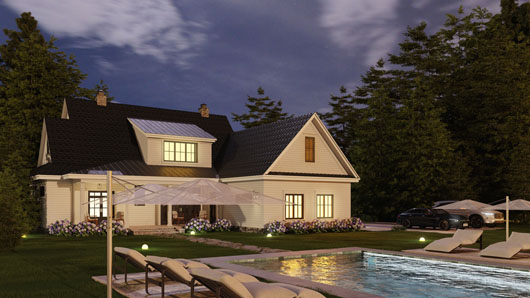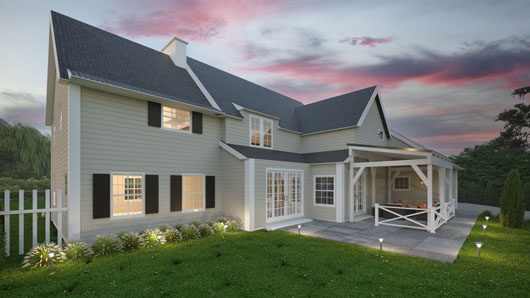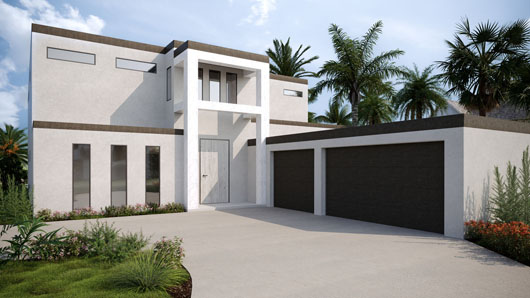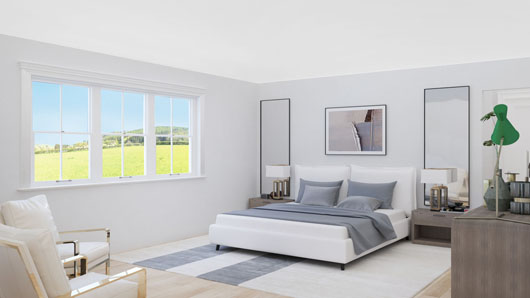3D House Rendering
Over the years, 3D residential renderings have become an indispensable tool for the construction industry. Architects, designers, and engineers heavily rely on 3D models when building future homes for their clients due to their accuracy and efficiency. The days when they depended on 2D models and drawings are long behind them because this method was ineffective in overcoming challenges and completing their home projects on time.
With impressive advancements in 3D computer-generated modeling over the past decade, clients can now visualize their home designs in real time with photorealistic textures.
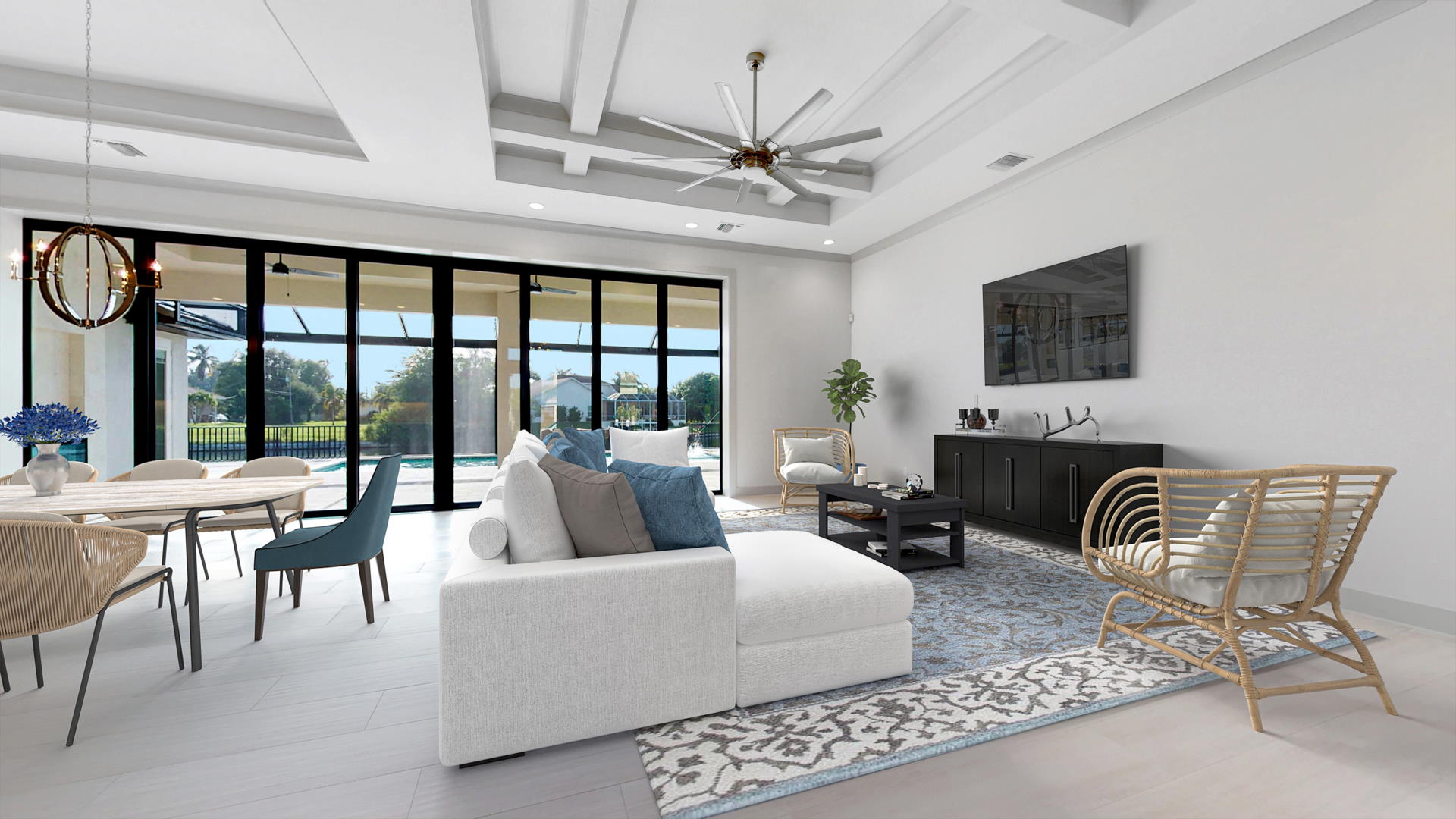
What Is 3D Rendering for Houses?
A 3D house rendering is a computer-generated 3D image showcasing what a completed property will look like even before the foundation is laid. The most common forms of residential visualization are 3D images, walkthrough tours, animations, and augmented reality (AR). Since they can create life-like renderings of houses, apartments, villas, condominiums, and other properties, these tools have become a crucial part of every designer’s workflow.
With the help of a 3D tour, architects can show clients every aspect of their homes, including the dimensions of the rooms, the transitions between spaces, and even the views from their windows. Furthermore, renderings give clients an idea of how their homes will fit into their surroundings, which is a significant consideration for those living in rural or suburban areas.
3D house renderings are also vital means of communication between designers and clients. This technology can make a residential project appear more realistic to clients, especially to those unable to read flat or black-and-white diagrams. Providing visual information automatically prevents any surprises down the road and ensures that both parties are on the same page. It also eliminates assumptions and questions and allows designers to make decisions before construction begins.
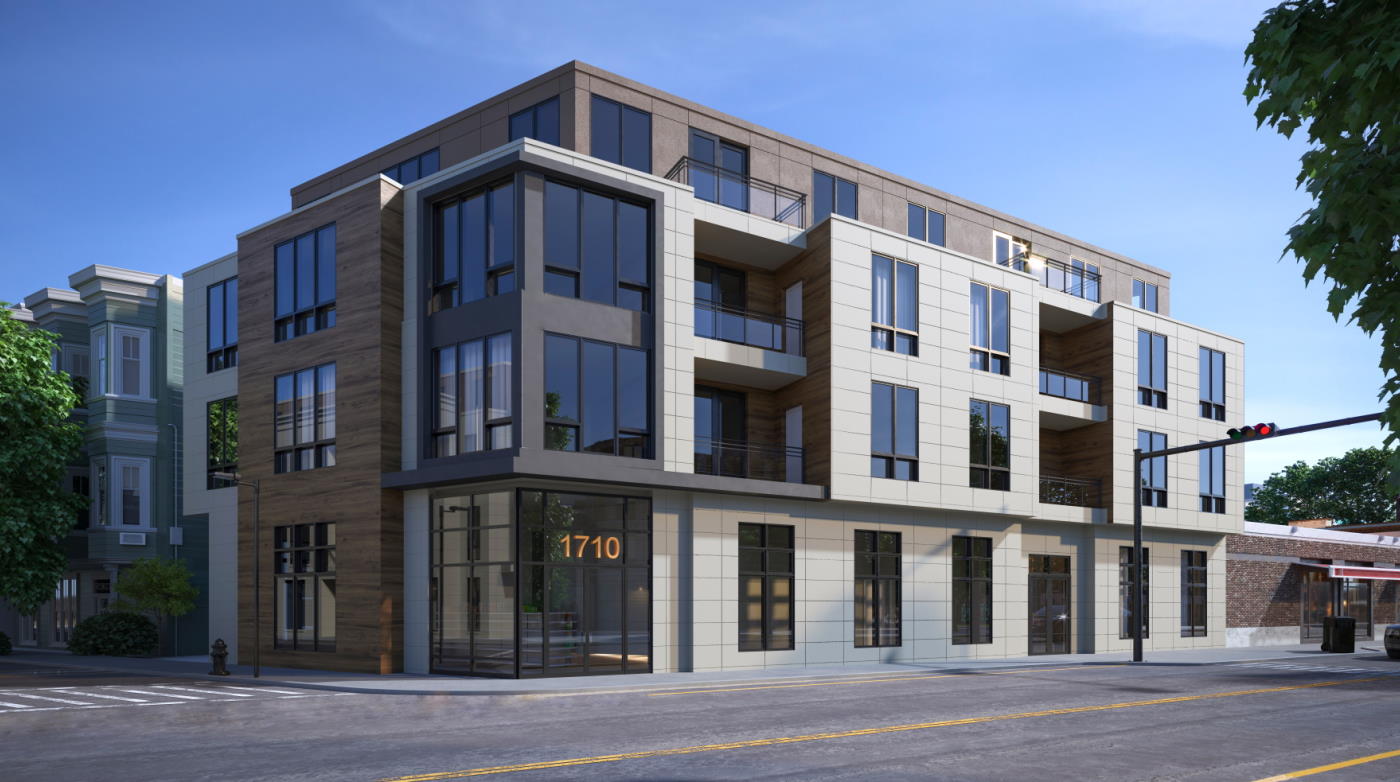
Types of 3D House Renderings
3D house visualization techniques include interior, exterior, floor plan, site plan, and landscaping renderings. They can be used during every stage of architectural construction, beginning with the initial plans and ending with the final product and marketing presentations for clients. Here’s how each of them works:
- Exterior renderings — 3D visualization creates a three-dimensional image of the house’s exterior, which is an excellent way of showing potential clients and investors the outside of a house in different styles. Furthermore, external visualization enables clients and target audiences to view the unique features of a project from any angle and understand how it fits in the neighborhood. With this technology, it is possible to add textures, lighting, and other elements that help create a more realistic representation of the property.
- Interior renderings — Interior 3D renderings show what a house will look like once it’s furnished and ready for sale. With the help of virtual staging, the designers paint a clearer picture by adding furniture, colors, and textures, allowing clients to maximize their space and get a real sense of the ambiance inside the home.
- Floor plan renderings — Rendering software can also be used to create 3D floor plans, which help clients and stakeholders see how the project will be laid out. By using this technique, they will be able to understand how different rooms flow together and how furniture and window placement, stairs, and doors fit into the overall design.
- Site plan and landscaping renderings — 3D site plans and landscaping renderings provide an excellent view of the area around the property, including greenery, pools, decks, porches, etc. They also show clients how their project will impact the overall landscape design.

Benefits of 3D House Rendering Services
Since people naturally gravitate toward visual presentations that are simple to understand, 3D renderings have revolutionized the real estate industry. Take a moment to learn about the benefits of this type of visualization.
Enhanced Design Visualization and Communication
With a brilliant 3D presentation that includes all the minute details, clients get to see every inch of their house up close. This is vital, as it provides an opportunity to clear any doubts and take action immediately. Being on the same page with clients reduces the number of alterations during the construction phase.
Improved Decision-Making and Client Approvals
3D residential rendering allows designers and architects to get immediate client feedback. This speeds up the approval process immensely, giving the designer a perfect grasp of the client's vision. Once given the green light, the artist can proceed to fine-tune the design.
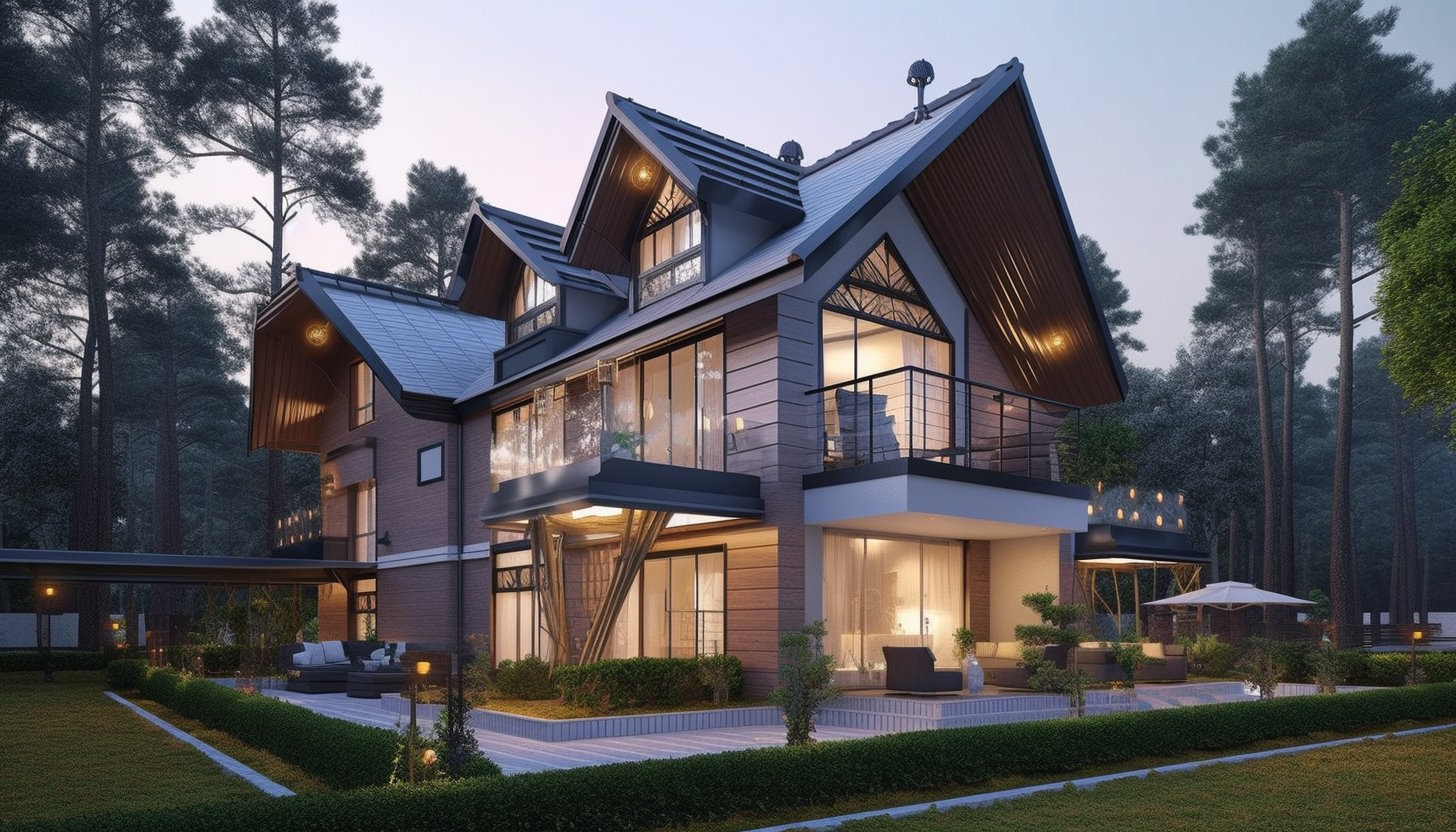
Increased Marketing Appeal and Competitiveness
Creating a photorealistic 3D rendering from a 2D floor plan gives artists a competitive edge from multiple perspectives. This method allows them to conduct effective marketing campaigns and presentations, capture the attention of potential clients, and explain the construction process more efficiently.
Time and Cost Savings Through Reduced Design Revisions
Constructing a place of residence is a big deal because clients approach designers and architects with a dream of building an ideal home while at the same time staying within their budget. 3D rendering allows clients to visualize the end result, making it easier for them to make quick and informed decisions, which, in turn, reduces costs and saves time. Thus, creating a 3D model is the safest and most efficient solution.
Greater Design Flexibility and Customization
Fundamentally, realistic 3D images have greater flexibility compared to other tools. For instance, you can share product ideas with prospective clients before designing begins. You can also see and, if necessary, alter every little detail and prevent problems at an early stage. This is beneficial to all parties involved in the design process and essential to the creation of a successful product.
Our 3D House Rendering Process
3D residential rendering takes more than completing a form and waiting for the results. Turning an idea into a finished product requires a great deal of talent and effort, as well as careful consideration of clients’ suggestions. Additionally, steps for completing the project can vary according to its size and the software the artist uses. In a nutshell, this is what our process typically looks like.
- Initial consultation and design assessment — We always hold an initial consultation with a client to discuss their vision and the project’s objective. The artist will request as many details as possible to understand what the customer wants, including visual references, such as drawings, photos, mood boards, or any other visual aid. The next phase begins when the designer has enough details to formulate a vision and determine how to proceed.
- 3D modeling and scene creation — It is necessary to have a 3D model before a 3D render takes place. It is a digital representation of the house, and it consists of rough geometric shapes without any details.
- Material, texture, and lighting setup — Designers must consider the material a property will be made of when creating a realistic model. They can adjust the texture and appearance to get the most realistic visual representation. This also requires taking into consideration light and its reflections, as well as shadows — without convincing lighting, the result may appear too artificial.
- Rendering and post-production adjustments — Once the light and texture are applied, the artist uses computer software to add the details that bring 3D renders to life.
- Final review, revisions, and delivery — After the client has seen the 3D rendering of their residential property, we will make changes to the product based on their input. We will continue refining the product until the client is satisfied.

Customizing Your 3D House Rendering Experience
3D rendering for houses provides unlimited possibilities due to its customization properties. Whether you are a homeowner, a property developer, or a realtor, our company makes sure you receive an exceptional 3D visualization of your project. This is what we pay attention to:
- Architectural styles and design preferences — Having worked with numerous companies worldwide, we can deliver 3D house renderings in various architectural styles, whether you need a single- or multi-family home, a villa, a condominium, or a modular house.
- Environment and context integration — This gives you a sense of how your home would work in real life. Thanks to exterior home renderings, you can observe how, for instance, landscaping and driveways would appear and how the house would complement the surrounding buildings.
- Daytime, nighttime, and seasonal variations — The developing process of 3D residential renderings also includes daytime and nighttime lightning, as well as sunlight orientation. Additionally, you will be able to see what your property would appear like in different seasons.
- High-resolution outputs and multiple formats — Our company delivers different high-resolution 3D rendering services for houses, including static images, animations, walkthrough tours, and AR.
Integrating 3D Rendering House Services Into Your Project Workflow
3D residential renderings are not only used by individual clients. The real estate industry also utilizes them in various presentations, architectural competitions, construction planning, and client meetings.
Design Presentations and Client Meetings
Since construction ideas are abstract and challenging to communicate, 3D renderings for houses represent a useful tool. We use them during presentations and client meetings because they are easy to understand — they help inspect the area from multiple angles and provide our clients with the essential characteristics of their properties.
Marketing Materials and Property Listings
We also use 3D residential renderings as a marketing tool in the real estate industry. They help advertise properties on many different platforms, from traditional print media to social networks. Additionally, they can be an effective way of marketing and selling unfinished properties. Thanks to 3D visualization tools, realtors don’t have to show blueprints and construction site photos any longer — they can instead present prospective buyers with photorealistic 3D renders of dwellings that are going to be built.
Architectural Competitions and Proposals
3D residential visualizations have become a significant part of architectural competitions. Architects have realized how important quality visual content is for the success of their projects and how effectively it can make them stand out from the competition. They usually use both non-realistic and photorealistic 3D renderings.
Construction Documentation and Planning
Regarding the construction industry, 3D residential visualization comes in handy in situations when, for instance, investors want to see the project documentation to understand what the project consists of and what the end result is set to look like. In addition to providing a visual representation of the interior and exterior of the building, it also gives them an instrumental insight from the mechanical, engineering, and plumbing aspects.
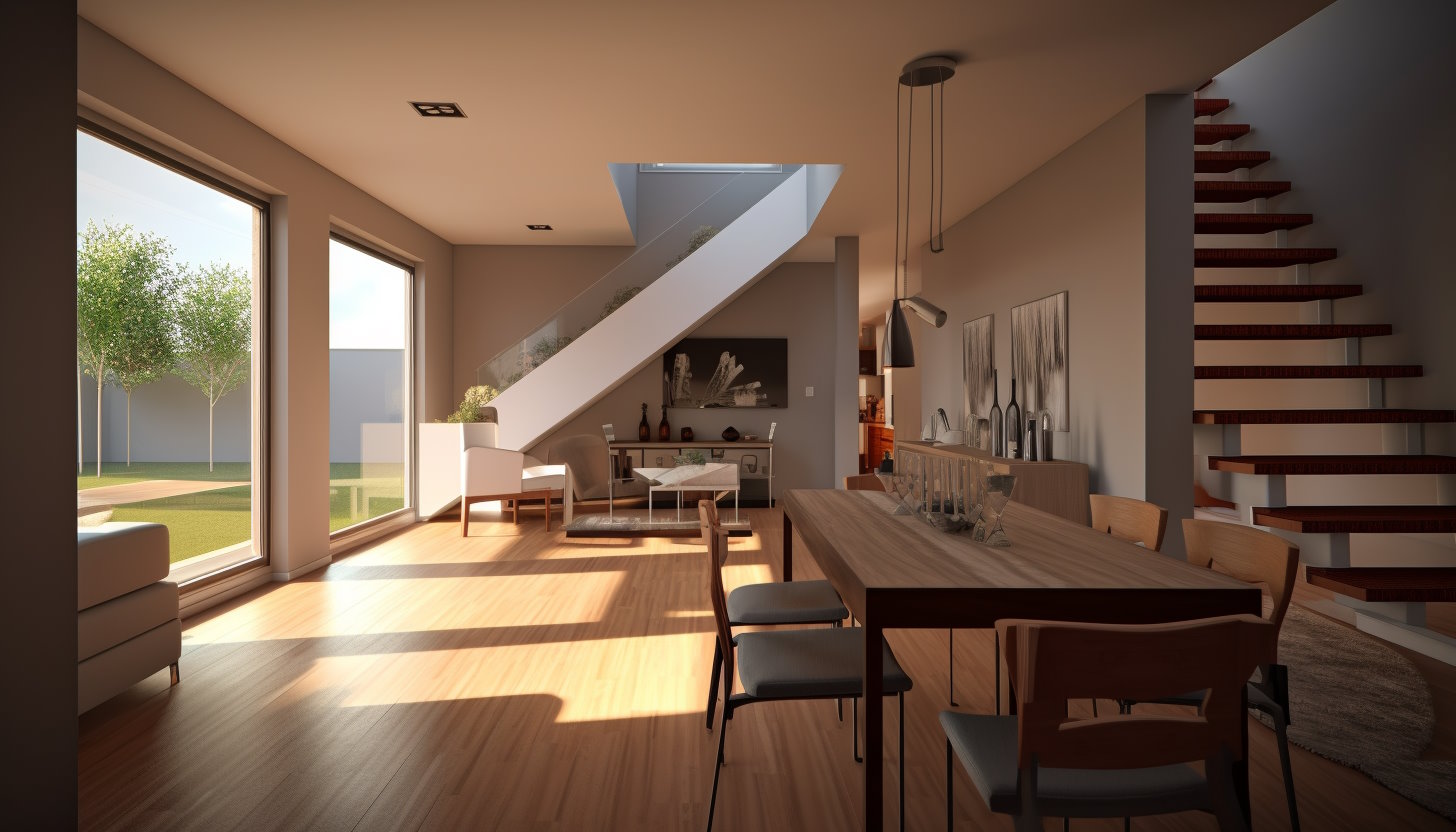
Why Choose Our 3D House Rendering Services
Aside from high-quality photorealistic images, our company guarantees fast turnaround time and professional service. This is what you can expect:
- Expertise in architectural visualization and design — Since our team has produced hundreds of renderings, from houses as large as thirty thousand square feet to tiny bungalows, we possess formidable knowledge and expertise in architectural visualization and design. Whether you want a detached home or a high rise, we can assist you while also offering to custom-make new models to suit your specific needs.
- State-of-the-art rendering software and techniques — Adhering to high-quality standards while maintaining a photorealistic appearance, we use state-of-the-art software to deliver top-notch results. Those include V-Ray, Fusion 360, Corona Renderer, Archicad, and several others.
- Attention to detail and realistic results — Being fully aware that our client’s needs can vary, we create unique solutions rather than taking a one-size-fits-all approach. We pay attention to every single detail of your specifications, be it a simple design with a standard floor plan or a fully custom project with unique features.
- Responsive customer service and support — We recognize the importance of knowledgeable, responsive, and professional customer support, which is precisely what our clients can expect from us. Whichever communication channel you use, we will ensure you receive your response swiftly.
- Competitive pricing and flexible packages — Our company is proud to deliver high-quality renderings at the price you can afford. We offer packages with pre-set prices, but if they don’t match your capabilities, we are flexible to adjust them.
- Fast turnaround times and commitment to client satisfaction — We promise fast turnaround times. Even if you are in a rush, our team will accommodate your schedule.
Get Started With Our 3D Rendering House Services
Once you have browsed our site and learned about our services and the prices of specific solutions, don’t hesitate to book a demo. Alternatively, you can contact us via the number provided on the website.
Email: kate@3dapartment.com
Phone: 786.567.3398
Frequently asked questions and additional resources
- The ability to view and evaluate a property before it's built or renovated
- The ability to make design decisions based on realistic visualizations of the property
- The ability to catch and address potential design issues before construction begins
- The ability to market properties more effectively by showcasing them in 3D virtual tours and walkthroughs
Conclusion
3D rendering for residential properties is an essential element in developing a project. With the assistance of this technology, designers can completely alter how they present their concepts and communicate with their clients. Detailed visualizations help clients and designers overcome barriers and make sure they are on the same page from start to finish. Even those without design experience can easily understand complex solutions and get more actively involved in the creative process.
Visualizing your residential property in 3D will increase your project's value and streamline the designing and building processes. Contact Listing3D to get high-quality 3D house rendering services.
3D Rendering Examples

